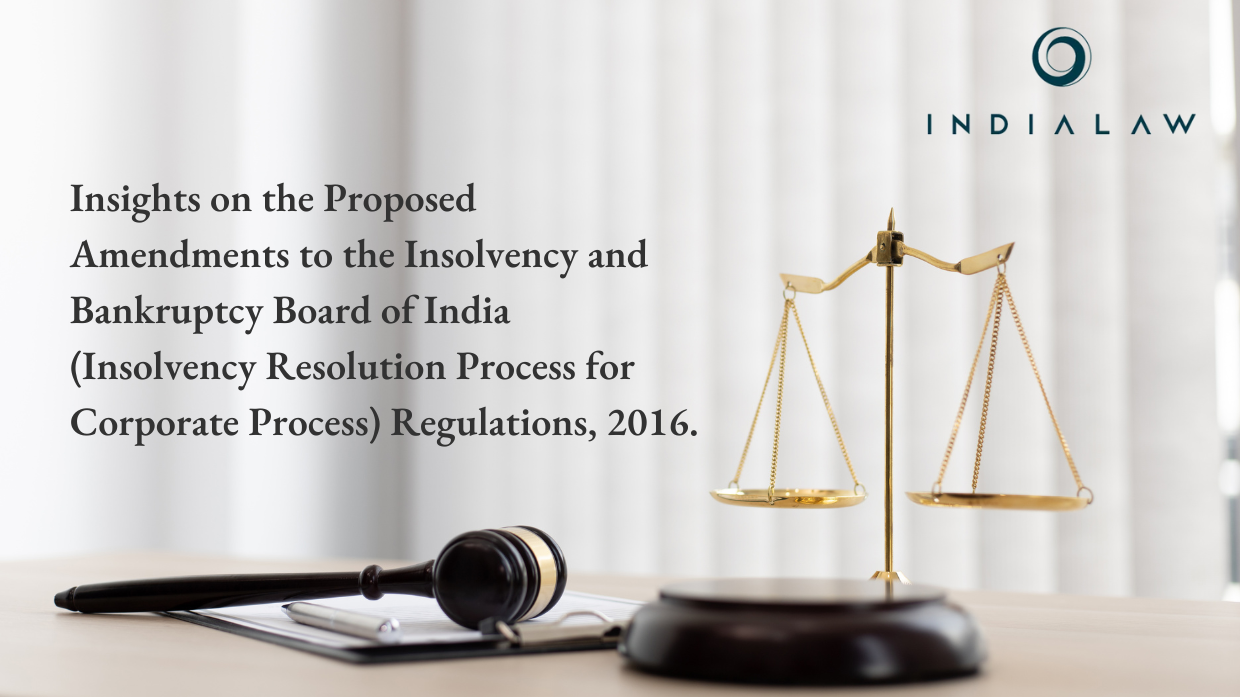Insights on the Proposed Amendments to the Insolvency and Bankruptcy Board of India (Insolvency Resolution Process for Corporate Process) Regulations, 2016.

The Insolvency and Bankruptcy Board of India (IBBI) released a discussion paper on 19th June, 2024, seeking comments on four proposed changes to the Insolvency and Bankruptcy Board of India (Insolvency Resolution Process for Corporate Process) Regulations, 2016. We have summarized our views and recommendations on the proposed amendments as follows:
Proposal 1: Registered valuer to submit valuation report for the Corporate Debtor (CD) as a whole.
To streamline the process and eliminate ambiguities in the current framework for appointing valuers for the valuation of the Corporate Debtor (CD), it is proposed to amend the CIRP Regulations to align with the Companies (Registered Valuers and Valuation) Rules, 2017. The amendment will specify that the Resolution Professional (RP) shall assign the task of valuing the CD as a whole to a single Registered Valuer (RV). This RV will conduct the valuation in accordance with Rule 8(2) of the Valuation Rules, incorporating inputs for other asset classes as needed or, if necessary, obtaining valuations for specific asset classes from other registered valuers.
This amendment aims to streamline the valuation process, reduce inconsistencies, and lower costs by potentially limiting the number of RVs required, while ensuring compliance with the established valuation rules.
Our View:
This change is expected to be significantly cost-effective for the Corporate Insolvency Resolution Process (CIRP) and will save a considerable amount of time. By appointing only two valuers instead of six, the expenses associated with hiring and coordinating with multiple professionals will be substantially reduced. Additionally, having fewer valuers will streamline the valuation process, leading to quicker decision-making and faster progression of the CIRP. The proposed amendment would also facilitate the Resolution Professional and Stakeholders by providing holistic valuation reports from two valuers. This approach would eliminate the need to analyze multiple valuation reports for each class of assets from different valuers, thereby streamlining the valuation process.
The proposed amendment seeks to harmonize the existing practices under the Insolvency and Bankruptcy Board of India (Insolvency Resolution Process for Corporate Persons) Regulations, 2016 (CIRP Regulations) with the Companies (Registered Valuers and Valuation) Rules, 2017 (Valuation Rules). Aligning the CIRP Regulations with the Valuation Rules not only resolves discrepancies but also ensures a more reliable and consistent valuation process through the appointment of two valuers.
Proposal 2: One valuation estimate for companies up to a certain asset size and for MSME Companies.
With a view to reduce the CIRP costs, for the CIRP of Corporate Debtors (CDs) with an asset size up to Rs. 1000 crore and those classified as MSMEs, it is proposed that the Resolution Professional (RP) shall appoint only one registered valuer by default to provide estimates of the fair value and liquidation value. However, considering potential complexities, if the Committee of Creditors (CoC) decides that two valuers are necessary, it must record the reasons for this decision before the RP proceeds with such appointments.
Our view:
The proposed amendment aims to expedite CIRPs for MSMEs and companies with a net worth of INR 1,000 crores by introducing a single valuation report. However, it may be challenging for the Resolution Professional (RP) and the Committee of Creditors (CoC) to determine whether the CD’s assets are below INR 1,000 crores and decide whether to appoint a single valuer or adhere to the proposed amendment of appointing two valuers for the CD . as a whole. Further, such decisions may be challenged, over burdening the Hon’ble NCLT with further avenue of litigations.
Relying solely on a single valuation risks inaccuracies and lacks a comparative basis, which is essential for accurate and fair valuations. Situations may arise where the claims of stakeholders exceed the valuation of the Corporate Debtor’s (CD) assets. In such instances, it becomes imperative to conduct precise and accurate valuations to determine both liquidation and fair value without any errors.
It is recommended that upon preliminary analysis, if the Resolution Professional (RP) and the CoC concludes that the valuation of the assets will be under Rs. 1000 crores, then a single valuer may be appointed. However, the Regulations should clearly specify that if the valuation report indicates that the assets exceed Rs. 1000 crores, then a second valuer shall be appointed. This measure avoids unnecessary litigations questioning the initial assessment of valuation by the CoC.
Ensuring accuracy in the valuation process is crucial, as it directly impacts the distribution of assets, the resolution of claims, and the overall fairness of the insolvency proceedings. The amendment, although intended to streamline processes, must be carefully considered to uphold high standards of valuation accuracy and competency.
Proposal 3: Voting by authorized representative before appointment by Adjudicating Authority.
When there are creditors in a class, the IRP obtains consent of three insolvency professionals (IP) to act as Authorised Representative (AR) under regulation 4A (3) of the CIRP Regulations, and indicates their names in the public announcement. The creditor in a class indicates its choice of an Insolvency Professional to act as its Authorised Representative. The Interim Resolution Professional (IRP) selects the Insolvency Professional, who is the choice of highest number of financial creditors in the class and make an application before the Adjudicating Authority (AA) for his appointment as the AR. The AA appoints the AR before the first meeting of the Committee of Creditors (CoC) under section 21(6A)(b). However, delays in the appointment prevent the authorised representative from attending the CoC meetings which adversely affects the creditors’ ability to exercise their rights.
To address this issue, IBBI has proposed that the IP, who is the choice of highest number of FCs in the class, shall be allowed to attend the meeting of the CoC after the IRP submits the application for his appointment before the AA. Along with request for his appointment as AR, RP shall also intimate AA for his continuation in-interim. In such cases, he will be required to perform the duties provided under section 25A read with regulation 16A of the CIRP Regulations in the intermediate period till decision of AA is available on his appointment or otherwise.
Our view:
The proposed amendment seeks to streamline the Corporate Insolvency Resolution Process (CIRP) by allowing the interim appointment of authorized representatives. This change is designed to prevent delays caused by legal proceedings related to AR appointments, which are often initiated by aggrieved financial creditors due to non-representation on the Committee of Creditors.
The proposed amendment is particularly beneficial for creditors who, despite filing their claims in a timely manner, fail to get proper representation in the CoC caused due to delays in the confirmation of the AR’s appointment by the Adjudicating Authority. By enabling interim AR appointments, the amendment ensures that such creditors are duly represented in the CoC without unnecessary delays, thereby safeguarding their interests and maintaining the integrity of the insolvency process.
Overall, it is a necessary adjustment to prevent delays and ensure fair representation of all creditors in the CIRP. By addressing the issue of non-representation promptly, the amendment promotes a more efficient and equitable insolvency resolution process.
Proposal 4: Release of guarantees in the Resolution Plan.
To ensure that there is clarity on the rights of the financial creditor to enforce recovery under guarantee agreements, it is proposed that CIRP Regulations to be amended to clarify that the resolution plan submitted by the resolution applicant shall not extinguish the rights of the creditors to proceed against guarantors and enforce realization of guarantees governed through various guarantee agreements.
Our view:
The proposed amendment bolsters creditors’ positions, ensuring they can pursue guarantors independently for any remaining balance if the resolution plan reduces amounts payable. This dual avenue for recovery—via the corporate debtor and guarantors—enhances the likelihood of full repayment, distributes recovery risk, and incentivizes more active guarantor participation in the resolution process. Consequently, this change promotes a more efficient recovery mechanism, strengthening the overall insolvency resolution framework and fostering a healthier credit environment.
The Supreme Court in Lalit Kumar Jain vs Union of India (2021) 9 SCC 321 held that the approval of a resolution plan does not automatically discharge a personal guarantor’s liabilities. The contrary stand taken by the Courts regarding the extinguishment of guarantee of the guarantors in the resolution plan and/or the rights of creditors to proceed against the guarantors, required a much-needed clarification which is now attempted by way of an amendment to the CIRP Regulations. However, in cases where creditors have agreed to discharge the guarantor along with the Corporate Debtor, the guarantee should indeed be extinguished. Mandating recovery from guarantors in all cases could lead to resolution applicants proposing reduced amounts, aware that creditors have an alternative recovery route.
In the context of MSMEs, Section 240A of the Insolvency and Bankruptcy Code (IBC) allows erstwhile promoters and undischarged sureties to submit resolution plans. The proposed amendment may discourage guarantors from participating, if their guarantees are not extinguished, potentially impacting very intend of revivals of MSMEs sector which was the ultimate reasons to permit promotor/directors of MSMEs to participate in the resolution process.
Therefore, in our considered view, instead of not allowing extinguishment of guarantees, the Resolution Plan should rather categorically provide/clarify as to how the guarantees would be treated after approval of Resolution Plan, which would certainly provide clarity in accordance with landmark judgment of the Hon’ble Apex Court in the case of Lalit Kumar Jain vs. Union of India.
Furthermore, the lack of clarity regarding the right of subrogation under the IBC, with contradictory judgments exacerbating the uncertainty, underscores the need for the Insolvency and Bankruptcy Board of India (IBBI) to provide definitive guidance. Addressing these concerns is essential to ensure a fair and effective credit framework that balances the interests of creditors, guarantors, and resolution applicants.
By entering the email address you agree to our Privacy Policy.



